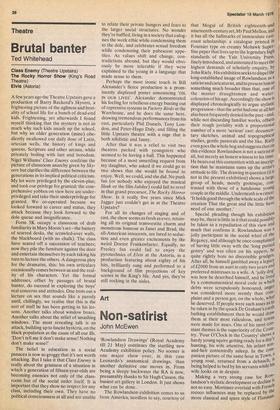Art
Non-satirist
John McEwen
`Rowlandson Drawings' (Royal Academy till 21 May) continues the startling new Academy exhibition policy. No sooner is one major show over, in this case Leonardo's anatomical drawings, than another definitive one moves in. From being a sleepy backwater the RA is now, presumably thanks to Sir Hugh Casson, the busiest art gallery in London. It just shows what can be done.
The Rowlandson exhibition comes to us from America, needless to say, courtesy of
that Mogul of British eighteenth-and nineteenth-century art, Mr Paul Mellon, and it has all the hallmarks of immaculate east' coast scholarship: a catalogue printed in Fournier type on creamy Mohawk Superfine paper that lives up to the legendary high standards of the Yale University Press, finely introduced, and annotated to meet the highest demands of scholarly enquiry, bY John Riely. His exhibition seeks to dispel the long-established image of Rowlandson as a satirist and caricaturist, and to present him as something much broader than that, one of the master draughtsmen and water.. colourists of his age. Accordingly the show '5 displayed chronologically to argue stylistic progression—that the artist had one at all has also been frequently denied in the past—and, while not discarding familiar works, offsets their rough joviality with a proportional number of a more 'serious' cast: documentary sketches, animal and topographical studies, gentle pastorals and the like. RielY even goes the whole hog and suggests that on this evidence Rowlandson is not a satirist at all, but merely an honest witness to his time. He bears out this contention with an inscrir tion that he maintains sums up the artist's attitude to life. The drawing in question (it IS not in the present exhibition) shows a large group of heads, mostly grotesque, contrasted with those of a handsome young couple in the middle. Underneath is written: 'It holds good through the whole scale of the creation That the great and the little have need of one another.'
Special pleading though his exhibition may be, there is little in it that could possiblY be taken as a repudiation of this view and much that confirms it. Rowlandson was a jolly participant in the social whirl of the Regency, and although he once complained of having little sway with the 'long pursed gentry' and was often on his uppers, he quite rightly bore no discernible grudges. After all, he himself gambled away a legaeY, of £2000 from an aunt in only two years an°, preferred mistresses to a wife. A 'jolly dug, was how he described himself, and he live' by a commonsensical moral code in which debts were scrupulously honoured, an was considered more seemly than coinplaint and a person got, on the whole, what he deserved. If people were such asses as le be taken in by the quack Dr Graham's earth bathing establishment then he would draw them at their most ridiculous, and towns were made for asses. One of his most constant themes is the superiority of the Conn° try. 'Four O'Clock in the Country' shows ,a hardy young squire getting ready for a day hunting, his wife attentive, his infant sonand-heir contentedly asleep. In the cool' panion picture of the same hour in Town,,a young roué, returned from a debauch, being helped to bed by his servants while hi wife looks on in despair. Making a very strong case for Row.. landson's stylistic development or decline not so easy. Mortimer overlaid with Fres° rococo influences may be replaced by the more classical and spare style of Flagman and so on, but such classifications are often confounded by changes induced simply by subject matter. Nor can it be said that the Cheap caricatures the artist did for Mr Tegg of Cheapside were any less interesting to him than the more polished work for Mr Ackerman of the Strand. Rowlandson delighted in the physical havoc wrought by age, dissipation and disease. Maimed debauchees and sporting coves were good to draw, and it is very probable that in many cases what appears to us as gross exaggeration was a relatively true representation of the facts. The charitability that came in With industrialism made this apparent indifference of Rowlandson to the misfortunes and physical deformities of others unacceptable to the Victorians, and for a time he was totally rejected. But Riely is right to draw attention to his gentler, less meaty side. And how suitable if he succeeds in prom°„ting Rowlandson back to the forefront of toe English watercolourists at the Royal A.cademy, where the artist first practised as
a student almost exactly two hundred years ago,
A new gallery, Blond Fine Art Ltd, has °Pened in Sackville Street. Declared policy !t the moment is to specialise in British art [tom 1910 to 1945 and the first exhibition (till 25 March) is of paintings and, mostly, Watercolours by John and Paul Nash. The Paul Nash barrel has now been pretty thoroughly scraped but there is one good oil of Rye Marshes and enough other oddsand-ends to demonstrate what a much better artist he was than his brother. Barry Martin (Taranman till 5 April) in the past has suffered as an artist from being t°0 much a jack-of-all-trades. His latest
Show is of small, mostly miniature, abstract Paintings. Several styles are displayed and the influence of John Hoyland is still too
aPParent in the more freely handled works, !:eat the overall effect is pretty and when he
is at his most severely geometric, the mode beSt suited to his present scale, a new individuality comes through.



































 Previous page
Previous page